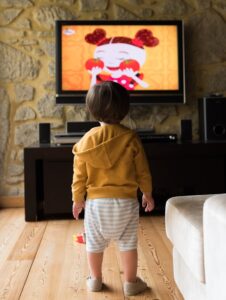 So many questions in the wake of Newtown, and an excellent one is about how television violence affects children. As some of the wiser commentators have said, there is no one single reason (not just guns, not just mental illness, not just family dynamics) for a tragedy of such heinous proportions. The question of how television violence affects children is just one thread of the complex tapestry of causes in such tragedies as the Newtown massacre.
So many questions in the wake of Newtown, and an excellent one is about how television violence affects children. As some of the wiser commentators have said, there is no one single reason (not just guns, not just mental illness, not just family dynamics) for a tragedy of such heinous proportions. The question of how television violence affects children is just one thread of the complex tapestry of causes in such tragedies as the Newtown massacre.
This tapestry surely finds its warp threads in the early days of a child’s life as the social brain is wiring up — during pregnancy, in infancy, toddlerhood and childhood. Important weaving also takes place in the equally tender developmental stages around adolescence.
This is a multi-layered issue, the now-infamous “onion” to which the Newtown police chief has often referred. Because I’ve received questions about the role of how television violence affects children, I will address that here. The issue of media in the life of children is its own onion, with many layers of issues. I deal with them at length in my book Parenting for Peace. Here are some adapted excerpts:
Television as a Neuro-Violent Experience
I want to zero in on effects that strike at the brain’s developing capacities for peace, joy and innovation. How might television undermine a blossoming generation of peacemakers? How might TV viewing redirect a child’s developmental orientation toward defensive protection rather than fully elaborated growth?
Producers long ago realized that children require far more novelty incidents (rapid cuts, zooms, pans, etc.) than do adults in order to hold their attention. And one of the most effective novelty incidents is an act of violence. Children’s programming features twice the number of violent acts than does primetime adult programming—and Saturday morning cartoons are known to feature up to twenty-five incidents per hour in which animated characters are stabbed, smashed, run over, and pushed off cliffs (but of course they don’t stay dead for long—huh?).
The cuts, pans and zooms that happen every few seconds on a television show elicit our brain’s instinctive reactivity to novelty, movement, and sudden changes in vision or sound. This orienting response is part of our mammalian heritage, designed to help us survive predators and other lurking threats. The television age marked the beginning of a vast neuropsychological experiment whose subjects are innumerable and who are us—from every race, country, culture, and socioeconomic group: What happens to people when for the first time in human experience they spend hours at a time having their orienting response subliminally triggered repeatedly every few seconds?
At the level of the brain’s automatic systems, the countless incidents of novelty programmed into a TV show—specifically engineered to keep the viewer’s attention from veering away from the tube—are double-edged swords that swipe Zorro-style at our neural pathways. It is instantaneous and imperceptible: the lower brain centers are snapped to attention for possible danger (with the attendant neurochemicals to prepare the body for fight, flight or freeze) and then are immediately relieved of the threat as the brain calculates at light-speed that there’s in fact no danger. This triggers the dopamine system, the brain’s pleasure center that evolved to reward us with a heady sense of euphoria when we escape harm or engage in other activities that promote survival of the individual and thus the species (think eating, drinking, sex).
The result is a brain that is alert, but not focused. Placated but not engaged. One effect of this alert/relief dialectic inside the brain is that television viewing has a numbing action, with a reaction in the body sometimes like that of a tranquilizer. Also, the repetitive dosing of the dopamine receptors can dampen the receptors in the brain’s pleasure center, making joy harder to come by through simple, human, non-technological means. When regarded this way—the actual process of television and not so much the content—it’s not hard to understand the growing body of research linking television with such neural regulatory problems as depression and attention deficit disorders.
(I have long suspected that many cases of ADD or ADHD are actually children in the grips of chronic inarticulable anxiety, such as happens in the wake of trauma—or possibly in the wake of sitting through dozens or hundreds of novelty events on TV. The child cannot focus on any one thing for a length of time because she is having to continually reorient in search of the threatening stimuli; it’s just that the stimuli aren’t out there in the world, but rather, internalized imprints on the brain, irritable neural pathways that are hyper-sensitive due to being continually triggered.)
How Television Itself Affects Children
This is an important angle from which to consider the issue of most screened entertainment, including so-called non-violent programming: the effect they have—not as an accidental side-effect, but as an intended unconscious process—is to put the child in a neurological state of protection rather than growth. It is on this basis alone that I recommend keeping screened media out of the standard diet of your child’s life.
While most of the focus and concern regarding television is on the troubling possibility of screened violence engendering violence, child psychologist David Elkind poses a chilling notion that I have rarely heard mentioned: what more effective way to provoke someone to aggression and violence than to keep them in a state of chronic fear and anxiety? Especially when they have no conscious awareness of why they feel that way.
 Apart from background anxiety disrupting attention, we see in brain scans that the level of gamma waves drops to almost a flatline during TV viewing. Gamma is the highest frequency brainwave, associated with perception and higher brain activity, which is present when we’re actively focused in on something. Is this what we want to train the young child’s brain to do as it wires up for life? I understand the common complaint from frustrated parents that sometimes television is the only time an active child will sit still and “pay attention”; the problem is, the child isn’t really paying attention but rather having his attention involuntarily stolen!
Apart from background anxiety disrupting attention, we see in brain scans that the level of gamma waves drops to almost a flatline during TV viewing. Gamma is the highest frequency brainwave, associated with perception and higher brain activity, which is present when we’re actively focused in on something. Is this what we want to train the young child’s brain to do as it wires up for life? I understand the common complaint from frustrated parents that sometimes television is the only time an active child will sit still and “pay attention”; the problem is, the child isn’t really paying attention but rather having his attention involuntarily stolen!
And all the while, the child’s own nascent powers of voluntary, conscious attention—the capacity to attend and be present, a central feature of the Generation Peace profile—languish and atrophy. Remember, the way a child uses his brain largely dictates how his brain develops. The brain regions meant to be engaged and bustling with activity at this age for optimally healthy psychosocial development, essentially go to sleep when a child watches TV. This establishes what Jane Healy in her book Endangered Minds refers to as the kinds of “habits of mind” that put them at a disadvantage at school.
Do we want to routinely flatline the higher brain centers responsible for perception, engagement and attention?
Does this mean that an occasional episode of Sesame Street will undermine a child’s trajectory toward unfolding into a person of peaceful innovation? Of course not—especially if she shares in that episode with one of her close adults. But because of that pesky trick it plays on the pleasure center of the brain, television is a slippery seductress: one episode a week so easily and insidiously becomes two, then a few, and then a daily dose, and so on. Power struggles ensue. It’s not a path I recommend starting down; it’s like tossing a handful of landmines onto your own road ahead as you set your intention on raising an individual with vibrant social and innovative intelligence.
Next post: Practical tips for parents wrestling with the television question
Images
by Samu Lopez on Unsplash
Josue Michel on Unsplash
Tags: ADD, adolescent brain, attention, brain development, Newtown, social brain, television, violence


